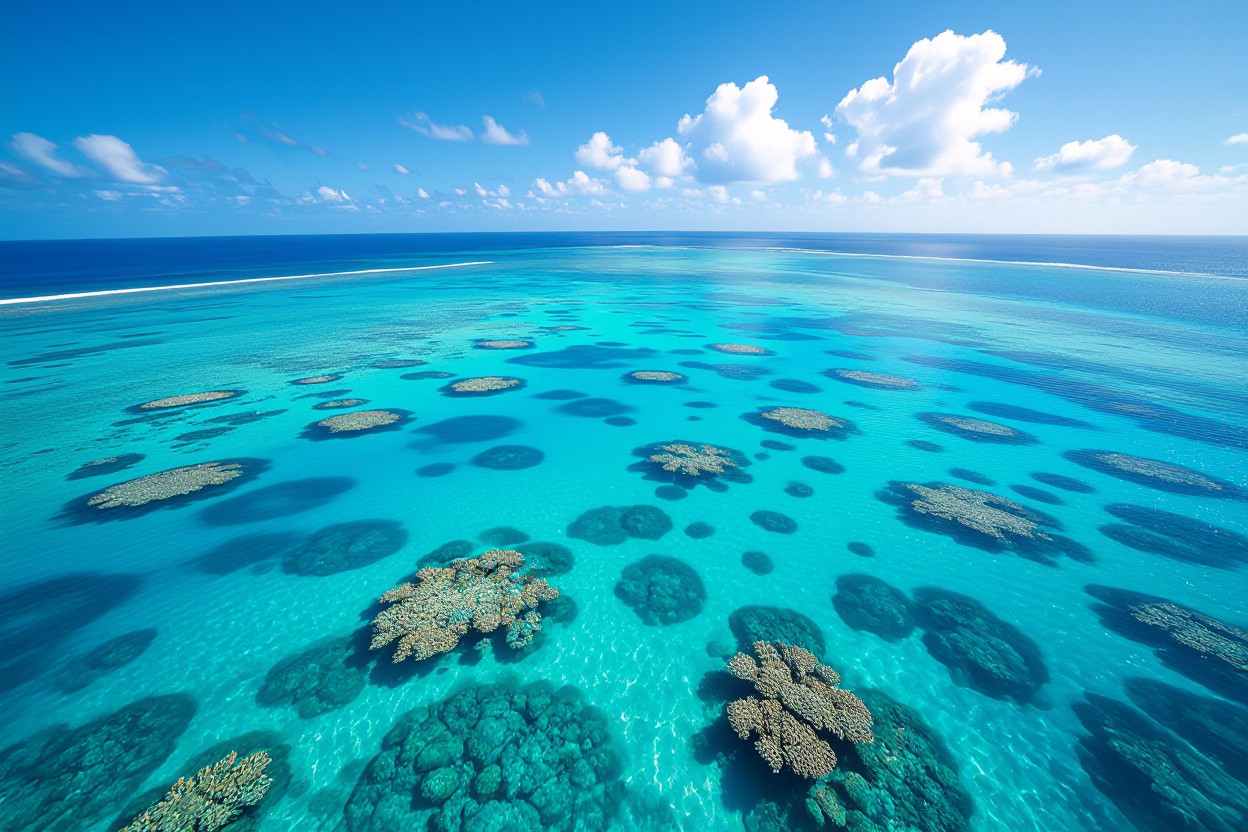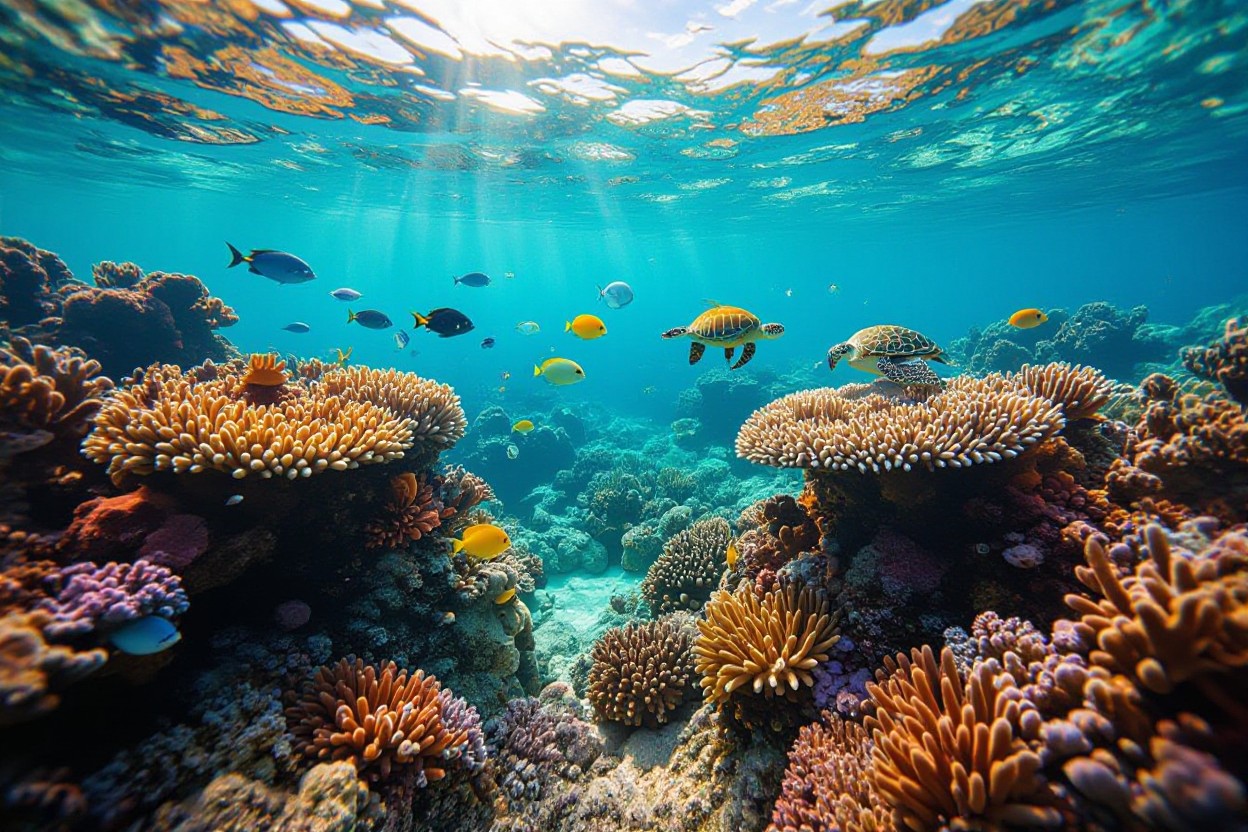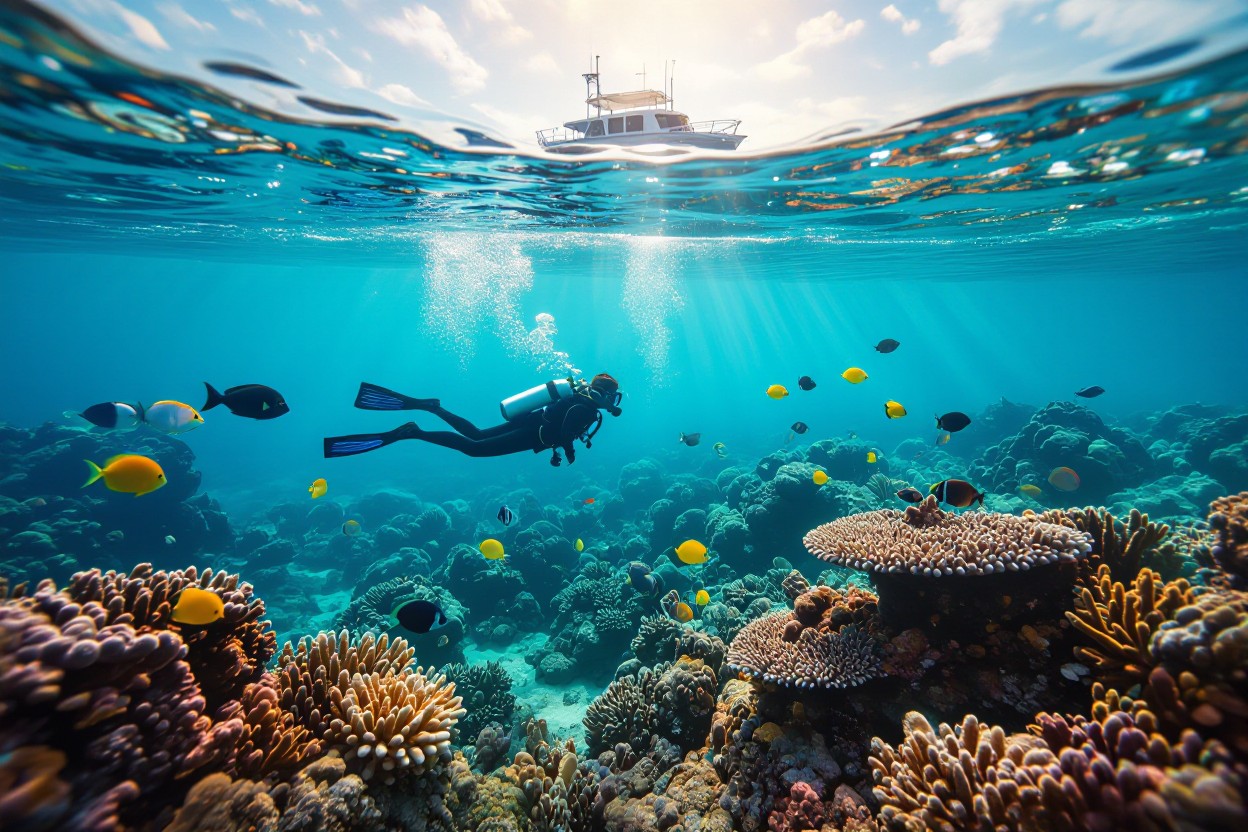Over 2,300 kilometers along Australia's northeast coast lies the Great Barrier Reef, the world's largest coral reef system. I've explored its vibrant underwater landscapes, teeming with diverse marine life and stunning coral formations. This natural wonder faces threats like coral bleaching and climate change, which makes understanding its location and ecosystem vital for preservation. In this guide, I'll help you navigate where to find this incredible reef and how to appreciate its beauty responsibly, ensuring your visit supports its ongoing protection.

Pinpointing Paradise: Locating the Great Barrier Reef
The Great Barrier Reef stretches over 2,300 kilometers off Queensland’s coast, marking it as the world’s largest coral reef system. You can find it beginning near the northern tip of Queensland, close to Papua New Guinea, and extending down to just south of Bundaberg. This dynamic marine landscape encompasses more than 900 islands and nearly 3,000 individual reefs, creating a mosaic of biodiversity that’s staggering in scale and variety. Knowing its precise boundaries helps in planning your exploration and appreciating the diversity held within this vast underwater world.
Geographic Boundaries and Key Points
The reef spans a vast section of the Coral Sea, from Cape York Peninsula in the north down to Lady Elliot Island in the south. This 344,400 square kilometer area covers tropical waters between 10 and 24 degrees south latitude along Queensland’s coast. Key points include Cairns, Port Douglas, and the Whitsunday Islands, each offering different types of reef access and marine environments. This extensive stretch features intricate reefs, lagoons, and sand cays that together form a natural wonder recognized for its uniquely complex ecosystem and geological history.
Major Access Points and Travel Routes
Cairns and Port Douglas serve as the primary gateways to explore the reef’s wonders, with numerous liveaboard boats, snorkeling tours, and diving excursions starting from these hubs. The Whitsunday Islands provide another popular access via Airlie Beach, known for combining reef visits with island experiences. For those wanting a more remote encounter, smaller ports like Cooktown and Lizard Island offer exclusive trips further north. Flights into Cairns or Hamilton Island and well-maintained road networks simplify your journey, making the reef accessible whether you seek adventure or relaxation.
Delving deeper, Cairns dominates as the most frequented hub, servicing hundreds of reef tours daily with modern facilities and dive centers offering courses from beginner to advanced levels. Airlie Beach, although smaller, attracts visitors looking to explore the Whitsunday Islands by boat or seaplane. Navigating north to Cooktown or Lizard Island involves more planning but rewards visitors with less crowded reefs and pristine underwater habitats. Seasonal weather patterns also influence travel plans, with the reef becoming less accessible in cyclone months from November to April, so I always advise checking current conditions before booking.

The Marvelous Ecosystem: Biodiversity Beneath the Waves
Diving beneath the surface of the Great Barrier Reef reveals a kaleidoscope of life, featuring over 1,500 species of fish and 400 types of coral. The reef supports vibrant seagrass beds, mangroves, and numerous invertebrates, creating a dynamic web of interactions that keeps this ecosystem flourishing. I find it fascinating how every organism, from the smallest plankton to the majestic sea turtles, plays a unique role in maintaining the reef’s health and resilience against environmental stresses.
Iconic Marine Species and Their Habitats
Species like the giant clam, clownfish, and the elusive dugong inhabit distinct reef zones, from shallow lagoons to deep reef slopes. The delicate balance among predators, herbivores, and reef-building corals shapes these habitats. For example, parrotfish graze on algae, preventing overgrowth that could smother corals, while butterflyfish navigate complex coral branches looking for food. Observing these relationships helps me appreciate the reef’s intricate design and the specialized niches each species occupies.
The Role of Coral Reefs in Ecosystems
Coral reefs act as natural coastal barriers, reducing wave energy by up to 97%, which protects shorelines and prevents erosion. Serving as nurseries, they’re crucial for the early life stages of many fish species, supporting fisheries that millions rely on for food and income. I’ve also seen how their calcium carbonate structures create habitats that foster biodiversity and maintain water quality by filtering pollutants and cycling nutrients through the environment.
Delving deeper, coral reefs contribute significantly to global carbon cycling by sequestering carbon in their skeletons, which helps mitigate climate change impacts. Their complex three-dimensional structures provide shelter to spawning fish, boosting population resilience in the face of environmental disturbances. Furthermore, reefs offer invaluable benefits to tourism and scientific research, driving economic growth and advancing our understanding of marine biology.
Journey Through Time: The History and Formation of the Reef
The Great Barrier Reef’s vast expanse reflects millions of years of natural history, starting from underwater coral polyps that slowly built the reef’s structure. Over the millennia, fluctuations in sea levels and climate shifts sculpted its complexity, creating diverse habitats. Coral growth rates combined with geological activity shaped a living maze covering more than 344,000 square kilometers. Walking through this timeline, you witness evolution not just biologically, but geographically, showcasing one of nature’s most remarkable natural constructions.
Geological Origins of the Great Barrier Reef
The reef began forming around 25 million years ago during the Miocene Epoch, when shifts in the Earth’s crust created a stable platform for coral to colonize. Rising sea levels over the last 20,000 years submerged ancient landmasses, allowing corals to expand upwards and outwards. The underlying continental shelf of Australia provided the perfect conditions with its warm, nutrient-poor waters. This fragile interplay between geology and oceanography enabled the reef’s characteristic extensive and complex coral formations you see today.
Cultural Significance to Indigenous Peoples
For over 60,000 years, Aboriginal and Torres Strait Islander communities have fostered a deep connection with the reef, regarding it not only as a vital food source but as a foundation of their spiritual and cultural identity. Their traditional knowledge about tides, fish behaviors, and seasonal changes continues to inform sustainable practices. Dreamtime stories and sacred sites scattered throughout the reef convey tribal laws and ancestral heritage, embedding the reef within indigenous cosmology and cultural continuity.
Diving deeper, indigenous stewardship practices such as seasonal fishing restrictions and reef monitoring highlight an intricate understanding of ecological balance. Many communities actively participate in modern conservation efforts, blending traditional knowledge with scientific research. This ongoing relationship underscores the reef’s role not just as a natural wonder, but as a living cultural landscape integral to Australia’s first peoples.
Conservation Challenges: The Fight Against Environmental Threats
Facing threats like coral bleaching, pollution, and overfishing, the Great Barrier Reef is under pressure more than ever. I find that these environmental challenges demand immediate action from both local communities and global stakeholders. Increasing sea temperatures and water acidity disrupt the delicate marine balance, threatening the reef’s survival. Your support for sustainable tourism and responsible fishing can make a difference in protecting this natural wonder for future generations.
Climate Change and Its Impact on Coral Reefs
Rising sea temperatures have triggered widespread coral bleaching, with one-third of the reef experiencing severe bleaching events since 2016. I see how ocean acidification weakens coral skeletons, making them fragile against storms and predators. This combination reduces coral growth rates and hinders recovery, shrinking vital habitats and endangering countless species that depend on the reef.
Conservation Efforts and Sustainable Practices
Australia’s government and environmental organizations collaborate closely to protect the reef through marine protected areas covering over 33% of the reef’s waters. I’m encouraged by initiatives promoting sustainable fishing, reducing agricultural runoff, and deploying innovative coral restoration techniques. Your choices as a visitor, such as opting for eco-certified tours, support these efforts and help lessen human impact on fragile ecosystems.
Beyond protected zones, extensive water quality improvement programs target harmful pollutants entering the reef from farms and urban areas, significantly improving ecosystem health year over year. Scientific breakthroughs in coral breeding and transplantation offer new hope, as resilient coral strains are cultivated to withstand higher temperatures. Engaging Indigenous knowledge has also enhanced reef management, blending traditional practices with modern conservation science to foster a holistic approach to preservation.

Navigating the Experience: Activities and Attractions
The Great Barrier Reef offers a plethora of activities, from scenic helicopter tours to underwater observatories. I recommend exploring the reef through glass-bottom boats for a surface view or kayaks for a more intimate encounter with the marine ecosystem. Cruises provide access to remote reef areas less frequented by tourists, where vibrant coral formations and schools of fish abound. Wildlife enthusiasts often venture out to spot dugongs and sea turtles, while photo buffs can capture breathtaking sunsets over the Coral Sea. Your experience hinges on choosing activities that match your interests and level of adventure.
Best Diving and Snorkeling Spots
Diving at the Ribbon Reefs near the northern Great Barrier offers encounters with manta rays and colorful coral gardens, ideal for experienced divers. Snorkelers flock to the clear waters around Green Island and Heron Island, where visibility can exceed 30 meters and vibrant marine life thrives. For a unique experience, Lady Elliot Island boasts a thriving population of green sea turtles and eagle rays, perfect for snorkeling. Each spot offers distinct coral structures and wildlife, so planning according to your diving skill will enhance your underwater exploration.
Eco-Tourism Opportunities and Responsible Travel
Embracing eco-tourism initiatives allows you to explore the reef while supporting conservation efforts. Many operators focus on low-impact tours that minimize reef disturbance and educate visitors about ongoing preservation. I suggest attending guided reef walks or participating in coral planting activities, which deepen your connection to the ecosystem. Opting for certified eco-tour operators ensures your travel choices help protect this UNESCO World Heritage site for future generations.
Programs like ‘Reef Restoration Foundation’ and ‘Citizen Science’ expeditions empower visitors to contribute directly to reef health. Engaging with indigenous-guided tours provides cultural insights alongside environmental stewardship. Touring with organizations that adhere to the Great Barrier Reef Marine Park Authority’s guidelines reinforces sustainable practices, reducing carbon footprints and waste. By choosing responsible travel options, you become part of a collective effort to preserve one of the world’s most fragile and spectacular ecosystems.
Conclusion
With these considerations, I hope you now have a clearer understanding of where the Great Barrier Reef is located and why it stands as one of Australia’s most remarkable natural wonders. If you plan to visit, knowing its vast expanse along Queensland’s coast will help you appreciate its biodiversity and resilience. Your journey to this incredible ecosystem will not only offer stunning underwater sights but also deepen your appreciation for the delicate balance that sustains the reef’s vibrant life. I encourage you to explore responsibly and support conservation efforts to ensure its beauty endures for generations to come.





Leave a comment